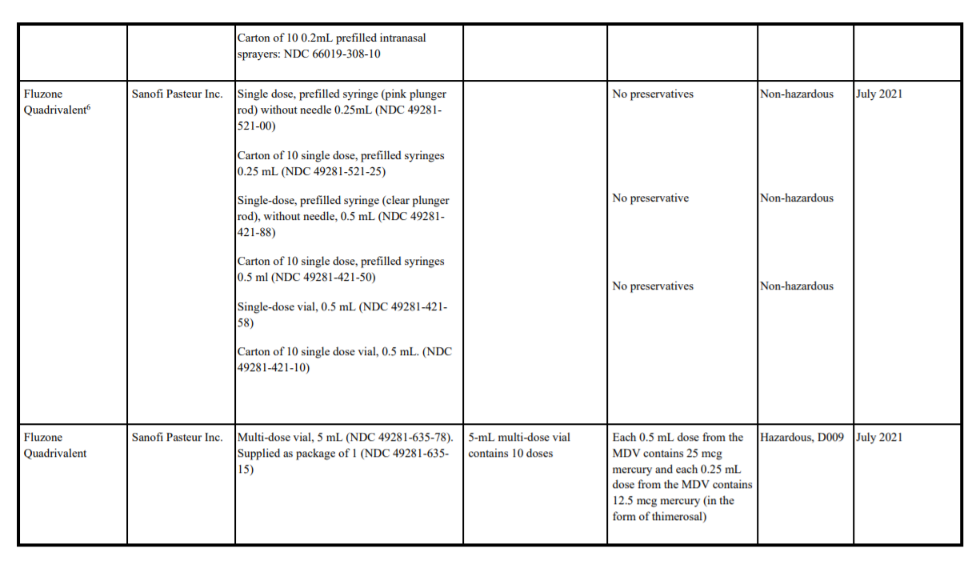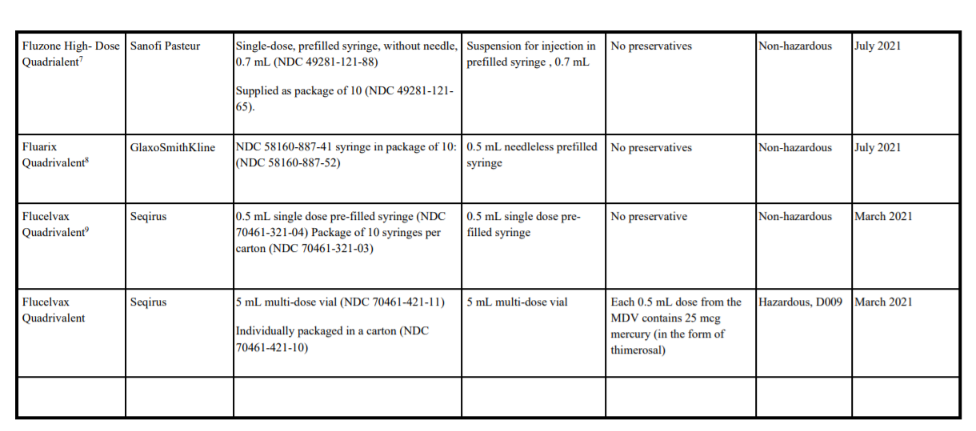PharmEcology Services, a division of WM Sustainability Services, is pleased to publish a summary of the proper flu vaccine disposal guidelines for the 2021-2022 flu season as a public service to the healthcare community. Please see also additional information regarding this year’s vaccines following the table below.
Flu vaccine summary table:
The table below summarizes the waste categorizations of the specific products available this season. Applying EPA’s federal regulations to the flu vaccines, the vaccines meet the toxicity characteristic when the concentration of mercury is equal to or greater than 0.2mg/liter as a result of performing a test known as the toxicity characteristic leaching procedure (TCLP). While we do not have results for such tests for vaccines, a calculation of the concentration of mercury in vaccines in which thimerosal is present as a preservative would cause the waste vaccine to fail the TCLP. Unless a manufacturer provides actual TCLP data indicating the mercury level to be below 0.2mg/liter or a healthcare facility has the test performed and the waste does not fail the TCLP, any vaccine waste containing thimerosal as a preservative should be managed as a toxic hazardous waste. As a result, all full or partially used multi-dose vials of the seasonal flu vaccine should be disposed of as federally hazardous waste, waste code D009 for mercury.

https://www.fda.gov/media/117022/download

1https://www.fda.gov/media/135432/download
2 https://www.fda.gov/media/123144/download
3 https://www.fda.gov/media/115785/download
4 https://www.fda.gov/media/120689/download

6 https://www.fda.gov/media/119856/download

New and updated information in this report includes the following items.
FDA's Vaccines and Related Biological Products Advisory Committee (VRBPAC) met in Silver Spring, Maryland, on March 5, 2021, to select the influenza viruses for the composition of the influenza vaccine for the 2021-2022 U.S. influenza season. During this meeting, the advisory committee reviewed and evaluated the surveillance data related to epidemiology and antigenic characteristics of recent influenza isolates, serological responses to 2020-2021 vaccines, and the availability of candidate strains and reagents.
7 https://www.fda.gov/media/139731/download
8 https://www.fda.gov/media/79278/download
9 https://www.fda.gov/media/115862/download
Influenza virus strains were selected based on the influenza vaccine production method; egg-based and cell- or recombinant based.
The committee recommended that the quadrivalent formulation of egg-based influenza vaccines for the U.S. 2020-2021 influenza season contain the following:
- an A/Victoria/2570/2019 (H1N1) pdm09-like virus;
- an A/Cambodia/e0826360/2019 (H3N2)-like virus;
- a B/Washington/02/2019- like virus (B/Victoria lineage);
- a B/Phuket/3073/2013-like virus (B/Yamagata lineage).
The committee recommended that the quadrivalent formulation of cell- or recombinant based influenza vaccines for the U.S. 2020-2021 influenza season contain the following:
- an A/Wisconsin/588/2019 (H1N1) pdm09-like virus;
- an A/Cambodia/e0826360/2019 (H3N2)-like virus;
- a B/Washington/02/2019- like virus (B/Victoria lineage);
- a B/Phuket/3073/2013-like virus (B/Yamagata lineage)
For trivalent influenza vaccines for use in the U.S. for the 2021-2022 influenza season, depending on the manufacturing method of the vaccine, the committee recommended that the A(H1N1) pdm09, A(H3N2) and B/Washington/02/2019-like virus (B /Victoria lineage) viruses recommended above for the quadrivalent vaccines be used. For additional extensive information about the flu vaccine, please visit the CDC website. Relevant links are listed below in the reference section.
Frequently Asked Questions (FAQs) regarding flu vaccine disposal:
What does this guidance provide?
Flu vaccine, including unused or partial vials and syringes, should be disposed of in accordance with applicable federal, state, and local regulations. For the purposes of this webpage, the guidance provided is to address the Resource Conservation & Recovery Act (RCRA) waste categorization requirement as it applies to flu vaccine waste. You should always check all applicable regulations, including your state and local regulations to ensure full compliance and / or please feel free to contact PharmEcology for additional information at info@pharmecology.com or by calling 877-247-7430.
How does the regulation (RCRA) apply to the flu vaccine?
Some of the flu vaccine products contain a preservative called thimerosal which is a mercury-based preservative which has been used for decades in the United States to prevent germ growth in multi-dose vials of vaccines. Under 40 CFR Part 261.24 if the waste contains one or more constituents at concentrations greater than those specified in the maximum concentration of contaminants for the toxicity characteristic, the waste is considered hazardous. The D009 toxicity characteristic applies for mercury-containing waste when the concentration exceeds the 0.2mg/L threshold (0.2 mg/L = 0.2 mcg/mL). Any flu vaccine containing thimerosal or for which thimerosal was used in the processing will also designate as a hazardous waste, D009.
The flu vaccine that we used is not hazardous. How do I dispose of it?
Flu vaccine waste that does not meet the definition of a hazardous waste under the Resource Conservation and Recovery Act (RCRA) may be disposed of with your other non-hazardous pharmaceutical waste, but you must consider your applicable state or local regulations. In addition, if a flu vaccine product contains live attenuated virus, such as FluMist, it should be disposed of as biohazardous. If you do not have a pharmaceutical waste procedure, please contact us for additional information.
The flu vaccine that we used is hazardous. How do I dispose of it?
If you have determined that your flu vaccine waste meets the definition of a hazardous waste, you must dispose of it as such. This includes appropriately segregating and managing it as a hazardous waste in your facility, usually in a black container. This does not mean placing it in a red sharps container, or another trash container. Please feel free to contact us if you need additional information.
How do we dispose of flu vaccine that is hazardous and also biohazardous?
In the rare instance that it is necessary to dispose of a full or partially used syringe with a needle containing a vaccine with thimerosal, the needle and syringe should be disposed of as dual hazardous and biohazardous waste. An unused vaccine in a vial cannot be both hazardous and biohazardous, as the thimerosal would kill the active virus.
Where may I find more information?
- For information on the flu, visit the CDC website at https://www.cdc.gov/flu/index.htm.
- For information on the flu vaccine including a table listing of all available forms of the vaccine for the 2021-2022 season, please see these tables from the CDC website: https://www.fda.gov/vaccines-blood-biologics/lot-release/influenza-vaccine-2021-2022-season;https://www.cdc.gov/flu/prevent/vaxsupply.htm
- For additional information on proper disposal of all pharmaceutical waste: please contact us at info@pharmecology.com or by calling 1-877-247-7430
References:
1. “Information for Healthcare Professionals: Influenza” https://www.cdc.gov/flu/professionals/index.htm
2. “Vaccination Guidance During a Pandemic” https://www.cdc.gov/vaccines/pandemic-guidance/index.html
3. “CDC HCP Fight Flu Toolkit.” https://www.cdc.gov/flu/professionals/vaccination/prepare-practice-tools.htm